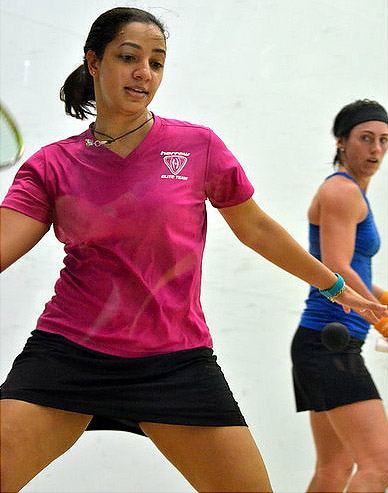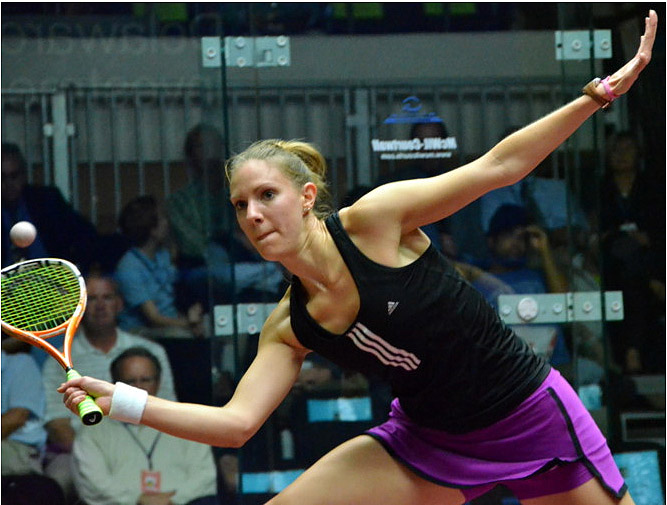WISPA Brooklyn/Philly Tour Stops May Have Far-Reaching Impact
by Rob Dinerman, for DailySquashReport.com
 Raneem El Weleily
Raneem El Weleily
Laura Massaro - photos courtesy Steve Cubbins
Dateline October 11th --- As the WISPA pro women’s singles tour heads back to Asia and Europe with events in Qatar, Holland (the Worlds) and Hong Kong in the next several weeks, a most intriguing question will be the extent to which its long-established dynamics will be affected by the just-concluded consecutive-week pair of events in the United States northeastern corridor. The Carol Weymuller tournament, held in the intimate confines of Brooklyn’s Heights Casino club on the last weekend of September, followed one week later by the Delaware Investment Group U. S. Open on the all-glass portable court in the spacious Daskalakis Athletic Center at Drexel University in downtown Philadelphia, saw a multi-front veritable shake-up of the status quo, the early-round ouster of longtime world No. 1 Nicol David, the pre-semis exit both times of two of the top-four seeds and the career-redefining performances of some bright new stars that may illuminate the WISPA planet for years to come. Three players --- Jenny Duncalf, Madeleine Perry and Kasey Brown --- reached the semifinals in both Brooklyn and Philadelphia, with none of them winding up in either of the winner’s circles, while the champions in each case (whose tournament experiences from one event to the other were mirror-images of each other to an eerie degree) emerged from the draw’s third quadrant.
On the second floor of the venerable three-story red-bricked structure on Montague Street, unseeded Raneem El Weleily, confronted by two match-balls against her in the fifth game of her opening-round match with fourth seed Laura Massaro, rescued that 13-11 game, then rallied from two games to love down to overtake Camille Serme in the quarters, where against the second-seeded Perry she let a 10-6 first-game lead slip away, eventually trailing 12-11 (game-ball-against) before erupting for SIXTEEN straight points en route to a straight-set win and a spot in her first-ever Gold-level WISPA final.
El Weleily’s opponent at that stage, the top-seeded two-time defending Weymuller champion and WISPA No. 2 Duncalf, had a ten-spot advantage over her in the WISPA rankings and a 4-0 mark against her head-to-head, none of which mattered in the face of a brilliant Sunday-afternoon performance that brought the wonderfully talented 22-year-old Egyptian to a resounding 11-7 15-13 11-4 triumph, emphatically shedding the double-edged “great potential” moniker and memorably announcing her arrival into the top echelon of the sport.
However, in a development that demonstrated how closely matched these elite players are, and how narrow the margin is between victory and defeat at this level, exactly seven days after her rousing Brooklyn breakthrough, it was El Weleily (rather than her opponents) who had a two-games-to-love lead disappear on her at Drexel and then was unable to convert multiple-match-balls in the fifth game. Four-time British Open champion Rachael Grinham, a 3-1 quarterfinal loser to her Australian compatriot Brown at Heights Casino, surmounted both the loss of the first two games (winning the third and fourth by 11-9 scores) and a trio of match-balls against her in the fifth, which she eked out 14-12 in an effort that took so much out of her that she had nothing left for her subsequent 11-3, 3 and 7 quarterfinal against Massaro.
The latter, as noted, had lost in the first round in Brooklyn and hence spent a week gearing towards a redemptive result in Philadelphia. This she indisputably would achieve in full measure when she followed her rout of Grinham with a straight-game semifinal win over Duncalf (who had thrashed her in the Weymuller final a year ago) and a decisive though four-game 5-11 11-5 11-3 11-5 final over Brown, who herself had had a resounding tournament, notwithstanding the final-round outcome, defeating David for the first time in 10 career tries in the quarters and out-playing Perry 3-1 in the semis. So El Weleily went from final-round win (after saving two first-round match-balls-against) to first-round loss (after holding three match-balls), while Massaro went from first-round loss (after holding two match-balls) to final-round win. El Weleily defeated an opponent she had never previously beaten in the Brooklyn final (her fourth win in 72 hours over a player ranked in the top ten), as did Brown in reaching the U. S. Open semifinals.
The pity of it all is that, while the cozy Heights Casino gallery was overflowing throughout the weekend with members, patrons and the omnipresent brood of juniors for which the club has long been known, by contrast the gallery at Drexel was rarely more than one-third full, even on the Thursday evening last week during which the men’s and women’s finals were played (see Bryan Patterson’s piece lamenting this very phenomenon posted October 9th on this web site). Moreover, there was very little vocal reaction from the spectators who did show up, most of whom seemed emotionally unengaged even as the best men’s and women’s players in the world were producing amazing squash in what by universal agreement was an extraordinary venue. Explanations for this absence of support on the part of the Philadelphia squash community were varied, ranging from the downtown location (most Philadelphia squash aficionados live, and often work as well, in the suburbs west of the city) to the presence of the hometown Philadelphia Phillies in the major-league-baseball playoffs throughout the week of the tournament to the perceived lack of nearby parking space, to the extremely early exit of the American players --- of the 12 combined U. S. men and women, 11 lost their very first match, 10 of them in the qualifying, in each case three games to love, the only exception being Amanda Sobhy, who did win two qualifying matches to make it into the main draw before running into Duncalf.
An additional factor whose existence and importance should not be overlooked is that, while Philadelphia’s status as a great squash town is firmly and deservedly entrenched, it is known far more for supporting the amateur game, especially the amateur doubles game, than for supporting the pros. At the annual William White tournament, for example, the members pack the impressive gallery of the main doubles court at the host Merion Cricket Club for even the early rounds of that weekend-long competition, whereas when the ISDA pros showed up there when Merion hosted an ISDA event several years ago, their matches were largely ignored and the pros were not invited back in the years that followed. For better or worse, the Philadelphia squash community lived up to this reputation, to the esthetic detriment of what was otherwise a splendid event put on by U. S. Squash and the host site.
Back To Main
